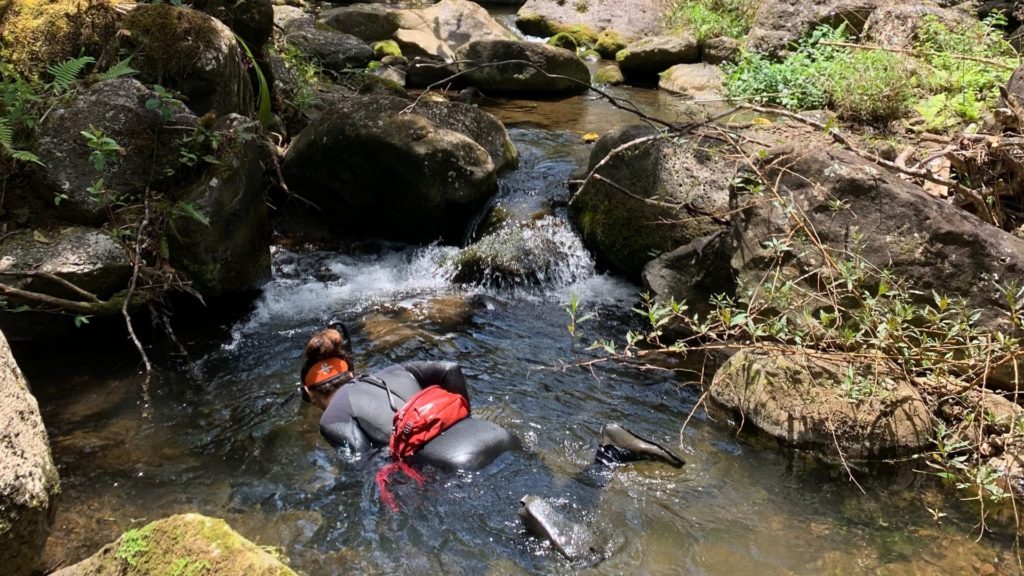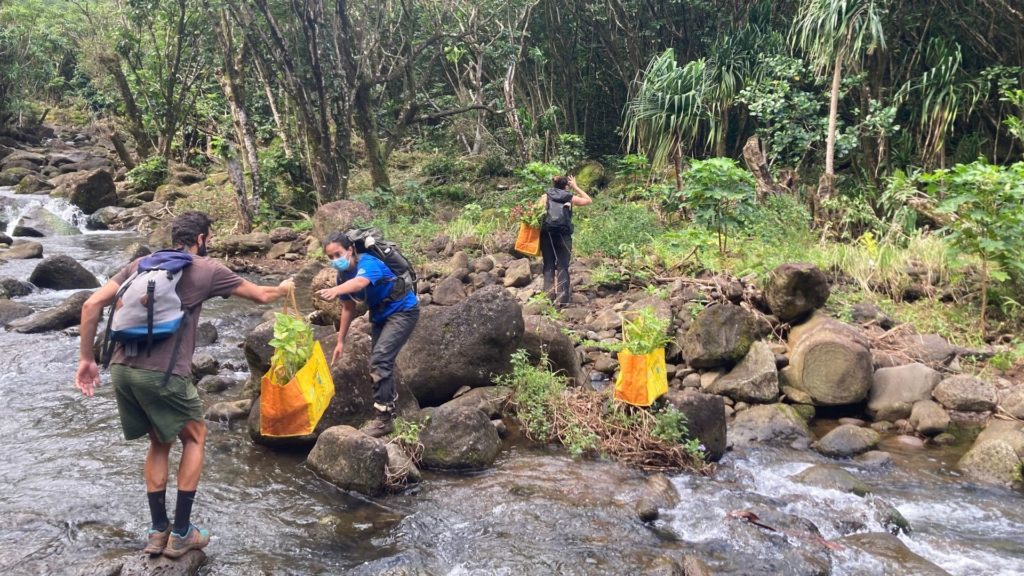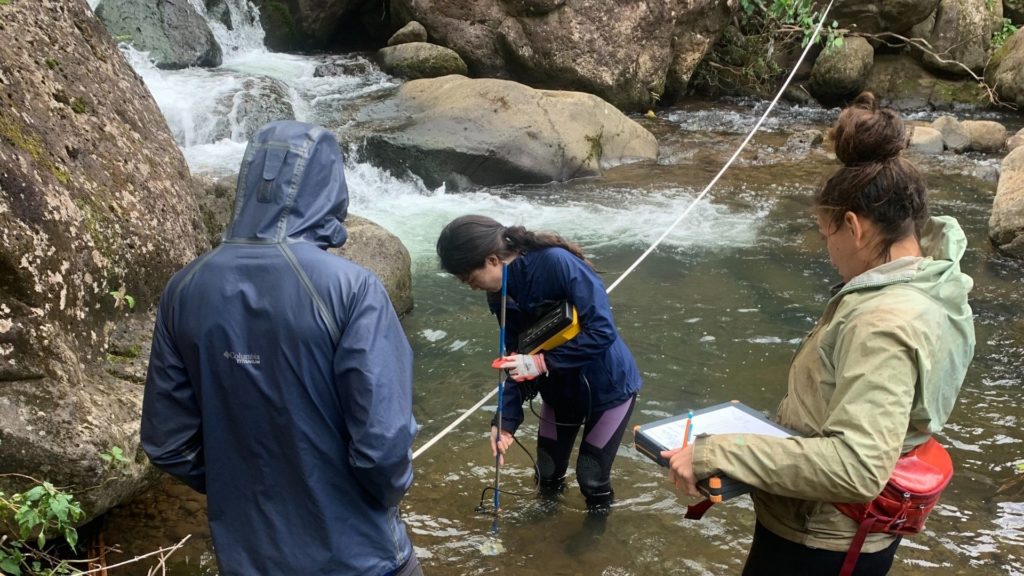by Dr. Uma Nagendra, Conservation Operations Manager, Limahuli Garden and Preserve with Puakea Moʻokini-Oliveira, Conservation Technician
In the middle of Limahuli Stream, cold mountain water cascades down boulders into a hip-deep pool. I am grateful for the wetsuit keeping me warm. Small river stones slick with algae slip beneath my tabis (water shoes). If I stay still, I might feel the dull pinch of Tahitian prawns nibbling my toes. Looking up at Limahuli Valley, I can see both sides of the cliffs where koae (white-tailed tropic birds) dart into their nests. I don my snorkel mask, nod to lead technician Puakea Moʻokini-Oliveira, who is standing on the bank with a timer and waterproof datasheets, take a deep breath, and dunk myself into the frigid water to enter the aquatic world of freshwater fishes.
Immediately, several oopu nakea[1] dart away along the stream bottom, leaving silty clouds in their wake. As I step in their direction, I can see an oopu alamoo resting on a dark stone, its bright orange tail curled slightly against the rock contours. I almost miss the crowd of oopu nopili grazing on a patch of green algae because they are so close to the waterfall cascade.

This underwater survey is a component of The Haʻena ʻOʻopu Restoration Project, a two-year project funded by the Hawaii Fish Habitat Partnership in order to enhance stream health and oopu population numbers in Limahuli Stream. Freshwater aquatic species like oopu were once a major food source, although now few Hawaii residents have ever seen one.
While this underwater world may feel completely removed from the terrestrial world we inhabit at NTBG, they are actually intricately intertwined. Limahuli Stream is the thread connecting all parts of the watershed from mauka to makai (mountains to the sea). From the mist caught by the ohia (Metrosideros sp.) canopy in the uppermost valley, filtered down through moss, leaf litter and soil, flowing underground through porous rock, or overland in rivulets and gulches, all the valley’s water eventually follows Limahuli Stream to the ocean.
“In Many ways, the health of the stream indictes the health of the rest of the valley.”
Dr. Uma Nagendra, Conservation Operations Manager
Streams carry carbon, nutrients, and silt to the reef. Riparian ecosystems (streams and stream banks) offer unique habitats for plants and animals that are adapted to constantly moist, periodically flooded conditions. In many ways, the health of the stream indicates the health of the rest of the valley. Healthy streams also provide critical ecosystem services such as clean water, erosion prevention, and food.
With the abandonment of traditional stream management practices and introduction of invasive species, stream health has declined throughout Hawaii. Stream diversions, blockages, and invasive species overgrowth have adversely transformed many riparian systems that were once highly productive and biodiverse ecosystems.
Although Limahuli Stream is considered “pristine,” with high levels of biodiversity and among the least disturbed stream systems on Kauai, it is home to far fewer oopu than neighboring Hanakapiai Stream. A past comparison of the two suggests that the amount of sunlight reaching the streams could be a major contributing factor to the lower population in Limahuli. Native green algae are the foundation of the riparian food web, and thrive in high light conditions. A promising pilot study led by NTBG research associate Kawika Winter[2] several decades ago tested this idea on a small scale. The Hāʻena ʻOʻopu Restoration Project expanded that study in order to see if opening up longer sunny stream corridors (as would have been maintained with traditional stream management) would also increase green algae growth and oopu populations.
One of the main activities of this project was the selective trimming of Schefflera actinophylla, a highly-invasive tree species that threatens the health and resilience of the riparian ecosystem by preventing sunlight from reaching the stream, which limits green algae growth. The tree’s high evapotranspiration rates and inhibition of understory growth reduce groundwater penetration and storage, contributing to flash floods and erosion. Schefflera’s sprawling growth forms also threaten the integrity of valuable cultural resources. For this project, invasive trees were trimmed by an experienced local arborist crew (Haleleʻa Tree Service), with the help of Limahuli Garden staff.

Afterwards, Puakea and I started planting on the freshly cleared stream banks, with the help of many other Limahuli staff, KUPU service members, and volunteers. We hand-carried and planted over 4,742 native plants like kokio keokeo (Hibiscus waimeae hannerae), hala (Pandanus tectorius), and many others[3].

The mix of species was selected in consultation with previous restoration managers and living collections experts at NTBG. These included species sourced from northwest Kauai, quick to establish and grow in riparian areas, and which have strong root systems that will help prevent future erosion on a now-vulnerable stream bank. We also chose a few species that are likely pollinated by moths (scented, white, night-blooming flowers) in order to further promote moth habitat, including endemic Hyposmocoma and the opeapea (Hawaiian hoary bat) that feeds on them.
Throughout the project, Puakea conducted stream surveys to assess how the aquatic wildlife were responding to this change. The entire 1,500-foot restoration area was divided into three 500-foot sections where we swam for an underwater census of the aquatic animals. We also surveyed a cross-section of different parts of the stream to document the algal growth, substrate composition, and stream characteristics like water temperature, flow rate, and canopy openness.

Spending so much time along the stream banks allowed us to observe just how many other species enjoy this area as well. By investigating the lower stream, Puakea was able to note how hīhīwai[4] migrated up the stream into our restoration zone — and even spotted their small pink eggs on the rocks. While we planted or weeded, we were often joined by an aukuu (Black-crowned Night Heron) standing statue-like to fish on a nearby boulder, or a pair of Koloa maoli ducks playing in the current.
One of the best parts of this project was working with school groups, volunteers, and partnering community organizations. Although COVID precautions limited our interactions after the first six months of the project, we were able to welcome two recurring classes from Kanuikapono Public Charter School, a work-exchange with the Waipā Foundation, and a new stream research collaboration led by the non-profit Nā Maka Onaona.
Our results indicated that canopy openness alone was not enough to boost oopu population numbers within the time frame of this project. Aquatic animal diversity remained high, however, and indicators of stream health such as temperature were unchanged. By restoring the stream banks to native habitat, the stream corridor should now be even more hospitable to native birds, bats, and invertebrates, and safer from the invasive tree falls that exacerbated flood impacts in 2018.
The completion of this project is just the start of this important new restoration area. In order to sustain those benefits, we will need to continue maintaining the stream corridor. Ongoing collaborative stream monitoring will also help improve our understanding of watershed resilience both in the Limahuli Valley and in freshwater systems all across Hawaii.
Editor’s note: The author wishes to thank those who contributed significantly to this project: Kawika Winter, Ashley Ramelb, Saori Umetsu, Moku Chandler, Noah Kaaumoana, Pelika Andrade, Mackenzie Fugett, Lauren Pederson, Matthew Kahokuloa Jr., Kassandra Jensen, Joshua Diem, Emma Stauber, and others. Funding for this project was provided by The Hawaii Fish Habitat Partnership, which is coordinated by the U.S. Fish and Wildlife Service.
[1] ʻOʻopu are species (Awaous sp.) of goby native to Hawaii. The three most common ʻoʻopu in Limahuli stream are ʻoʻopu nākea (Awaous guamensisi), ʻoʻopu alamoʻo (Lentipes concolor), and ʻoʻopu nōpili (Sicyopterus stimpsoni)
[2] Dr. Kawika Winter was director of Limahuli Garden and Preserve from 2005 to 2018.
[3] Including koaia (Acacia koaia), māmaki (Pipturus kauaiensis), ʻākia (Wikstroemia oahuensis), koʻokoʻolau (Bidens forbesii forbesii), and ground covers such as ahuʻawa (Cyperus javanicus), makaloa (Cyperus laevigatus), pili (Heteropogon contortus) and ʻaeʻae (Bacopa monnieri).
[4] Endemic freshwater snail (Neritina granosa)